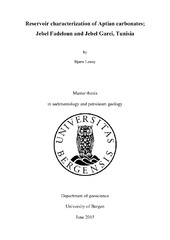Reservoir characterization of Aptian carbonates; Jebel Fadeloun and Jebel Garci, Tunisia
Master thesis

View/
Date
2015-06-02Metadata
Show full item recordCollections
- Department of Earth Science [1034]
Abstract
This thesis presents the results of detailed petrographic and diagenetic analyses of the Aptian Serdj Fm. at the Jebel Fadeloun and Jebel Garci localities in northern Tunisia. The Serdj Fm. was deposited in a distally-steepened, open and temperate water carbonate ramp. The ramp was divided into eleven microfacies and eight sedimentary units, and vertical lithostratigraphic logging and petrographic studies were performed in order to establish the microfacies distribution. The ramp consists of four shallowing upward sequences deposited during an overall long-term regressive trend, and is dominated by packstones and grainstones. The sequences are separated by minor flooding events which are characterized by abrupt changes in grain size and sedimentary texture. The Jebel Fadeloun locality is dominated by mid- to inner ramp facies, with early Aptian deposits represented by massive, locally karstified, orbitolinid- and miliolid-rich beds. Mid- Aptian deposits are characterized by intensively bioturbated bivalve-, echinoderm- and peloidal-rich beds with variable input of terrigenous quartz. Late Aptian is dominated by echinoderm-dominated deposits, and is capped by an unconformity representing the Aptian- Albian boundary. The Jebel Garci locality represents a more distal Aptian depositional setting with a condensed section of mid- to outer ramp deposits, capped by a highly bioturbated hardground. Detailed thin-section studies and geochemical analyses indicate that the first stages of diagenetic alteration took place shortly after deposition, by microbial micritization and precipitation of fibrous to granular marine cements. Non-ferroan equant calcite cement precipitated at relatively shallow burial depths and/or during meteoric diagenesis. Pendant cement precipitated within the fresh-water vadose zone, during periods of subaerial exposure. Mouldic porosity formed by meteoric and/or burial diagenesis. Stylolites formed in response to increased pressure and associated pressure-dissolution during burial. Ferroan equant calcite cement is related to late diagenesis and postdates, at least to some extent, oil migration. Some of this cement was later dissolved. Image analyses and plug measurements show that the porosity is mostly less than 6 percente in Jebel Fadeloun, and less than 1 percente in Jebel Garci. TinyPerm and plug measurements generally show permeabilities less than 0.1mD. A few beds show permeabilities of up to 1 Darcy, and are probably related to open fractures and/or measurement inaccuracies. Highest porosities and II permeabilities are observed within terrigenous-rich beds and inner ramp deposits, and reflect less cementation, increased fracturing, and increased dissolution of both grains and cements. The observed reservoir quality may be significantly better in a reservoir situation due to the inhibiting effect of oil on late ferroan calcite cementation. STOOIP calculations based on minus-cement porosity (porosity plus ferroan calcite cement) show potential reserves that may be of economic significance.